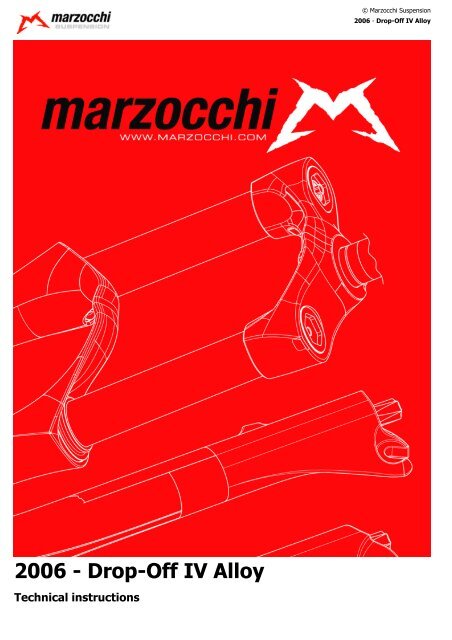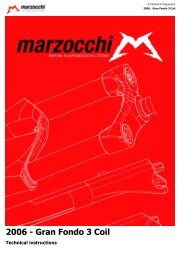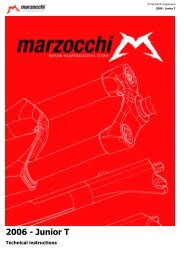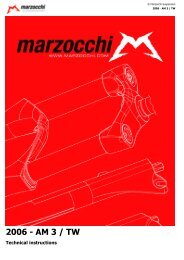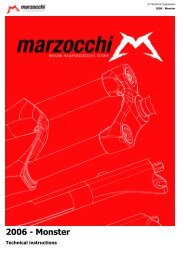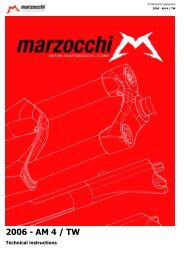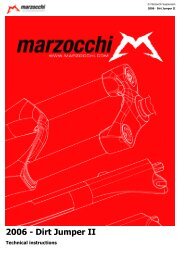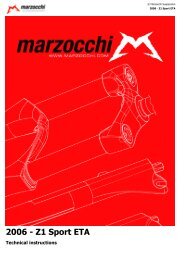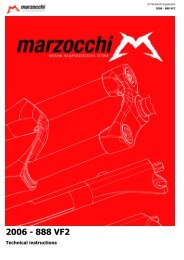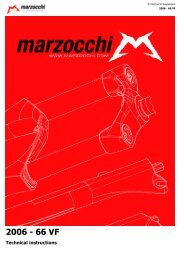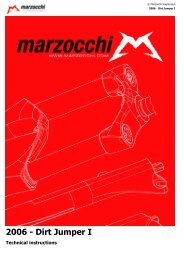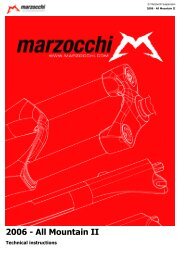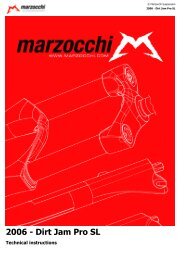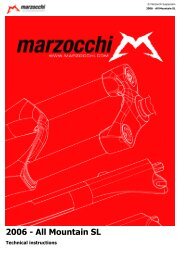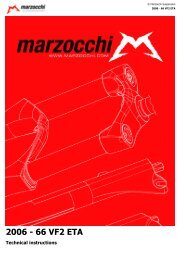2006 - Drop-Off IV Alloy
2006 - Drop-Off IV Alloy
2006 - Drop-Off IV Alloy
- No tags were found...
Create successful ePaper yourself
Turn your PDF publications into a flip-book with our unique Google optimized e-Paper software.
© Marzocchi Suspension<strong>2006</strong> - <strong>Drop</strong>-<strong>Off</strong> <strong>IV</strong> <strong>Alloy</strong><strong>2006</strong> - <strong>Drop</strong>-<strong>Off</strong> <strong>IV</strong> <strong>Alloy</strong>Technical instructions
© Marzocchi Suspension<strong>2006</strong> - <strong>Drop</strong>-<strong>Off</strong> <strong>IV</strong> <strong>Alloy</strong>Exploded view - <strong>Drop</strong>-<strong>Off</strong> <strong>IV</strong> - 130 <strong>Alloy</strong>Rif. Code Quantity<strong>Drop</strong>-<strong>Off</strong> <strong>IV</strong> - 130 <strong>Alloy</strong> - Oil levelsPosition Oil type Quantity (cc)Right fork leg SAE 7,5 - 550013 150Left fork leg SAE 7,5 - 550013 150
© Marzocchi Suspension<strong>2006</strong> - <strong>Drop</strong>-<strong>Off</strong> <strong>IV</strong> <strong>Alloy</strong>Exploded view - <strong>Drop</strong>-<strong>Off</strong> <strong>IV</strong> - 130 <strong>Alloy</strong> TARif. Code Quantity<strong>Drop</strong>-<strong>Off</strong> <strong>IV</strong> - 130 <strong>Alloy</strong> TA - Oil levelsPosition Oil type Quantity (cc)Right fork leg SAE 7,5 - 550013 150Left fork leg SAE 7,5 - 550013 150
© Marzocchi Suspension<strong>2006</strong> - <strong>Drop</strong>-<strong>Off</strong> <strong>IV</strong> <strong>Alloy</strong>Exploded view - <strong>Drop</strong>-<strong>Off</strong> <strong>IV</strong> - 150 <strong>Alloy</strong>Rif. Code Quantity<strong>Drop</strong>-<strong>Off</strong> <strong>IV</strong> - 150 <strong>Alloy</strong> - Oil levelsPosition Oil type Quantity (cc)Right fork leg SAE 7,5 - 550013 150Left fork leg SAE 7,5 - 550013 150
© Marzocchi Suspension<strong>2006</strong> - <strong>Drop</strong>-<strong>Off</strong> <strong>IV</strong> <strong>Alloy</strong>Exploded view - <strong>Drop</strong>-<strong>Off</strong> <strong>IV</strong> - 150 <strong>Alloy</strong> TARif. Code Quantity<strong>Drop</strong>-<strong>Off</strong> <strong>IV</strong> - 150 <strong>Alloy</strong> TA - Oil levelsPosition Oil type Quantity (cc)Right fork leg SAE 7,5 - 550013 150Left fork leg SAE 7,5 - 550013 150
© Marzocchi Suspension<strong>2006</strong> - <strong>Drop</strong>-<strong>Off</strong> <strong>IV</strong> <strong>Alloy</strong>Technical characteristics: Technical characteristicsSingle-crown fork with ø 32mm legs.Available travels: 110 mm, 130mm, 150 mm.Right fork leg damping element: spring (air pre-load).Left fork leg damping element: air.Right fork leg damping system: VF2 pumping element with internal rebound adjustment.Left fork leg damping system: pumping element.The stanchion tubes are pressed into the crown with a cryogenic process.Lubrication and cooling of the parts subject to friction with a specially formulated oil.Steer tube: steel or (optional) reinforced aluminium, 1-1/8", threadless.Crown: aluminium alloy forged and CNC machined.Stanchions: anodised aluminium.One-piece assembly: made of magnesium alloy cast and CNC machined for lighter weight and more stiffness.Sliding bushings: made of friction-free and wear-free material.Seals: computer designed oil seals that guarantee maximum seal in any condition.Oil: specially formulated oil that prevents foam and keeps the viscosity unchanged while offering high performance; free from static friction.<strong>Drop</strong>out type: standard or (optional) with ø 20mm through-axle.Disk brake mount: XC International Standard for 6" disk (fitting the special adapter supplied by the brake system manufacturer you can install the8" disk).Max wheel size: 2.8" x 26".Integrated fender: available as optional.
© Marzocchi Suspension<strong>2006</strong> - <strong>Drop</strong>-<strong>Off</strong> <strong>IV</strong> <strong>Alloy</strong>Warnings: Instructions for useMARZOCCHI forks are based on an advanced technology coming from the company’s years long experience in the professional mountain bikeindustry.For the best results, we recommend inspecting and cleaning the area below the dust seal and the stanchion tube after every use and lubricating theparts with some silicone oil.MARZOCCHI forks usually offer the best performances since the very first rides. Notwithstanding this, a short running-in period may be necessary(5-10 hours) to adjust the internal couplings. This precaution will lengthen your fork’s life and guarantee its best performances.We recommend changing the oil at least every 100 hours.The forks with a polished finish must be treated periodically with polishing paste to keep the exterior shining like new.Warnings: General safety rulesAfter disassembling the forks, always use new, original Marzocchi seals when reassembling.To tighten two bolts or nuts that are near each other, always follow the sequence 1-2-1, and tighten to the required tightening torque.Before reassembly, wash all new and old components and dry them with some compressed air, making sure there are neither breaks nor burrs.Never use flammable or corrosive solvents when cleaning the forks, as these could damage the fork’s seals. If you must use a solvent, usebiodegradable detergents that are not corrosive, non-flammable, or have a high flash point.Before reassembling, always lubricate those components that are in contact with the fork’s oil.If you are planning not to use your forks for a long period of time, always lubricate those components that are in contact with the fork’s oil.Always collect and keep any lubricants, solvents, or detergents, which are not completely biodegradable in the environment. These materials shouldbe kept in appropriate containers, and disposed of according to local laws.Always grease the seal lips before reassembling.All of the components of Marzocchi forks require the use of metric tools. Use only metric tools. Imperial (US) tools may have similar sizes, but candamage the bolts, making them impossible to loosen or tighten.When using a screwdriver to assemble or disassemble metal stop rings, O-rings, sliding bushings, or seal segments, avoid scratching or cutting thecomponents with the screwdriver tip.Do not carry out any maintenance and / or adjustment operations that are not explained in this manual.Only use original Marzocchi spare parts.Before servicing the fork, we recommend washing the fork thoroughly.Work in a clean, organized, and well-lit place. If possible, avoid servicing your forks outdoors.Carefully check to see that your work area is free of dust and metal shavings from any component of the forks.Never modify your fork in any way.Warnings: Fitting the fork onto the frameThe fork is supplied with “A-Head Set” steer tube to be cut to size according to frame being used.Fitting the fork onto the bike frame is a very delicate operation that must be carried out at one of our service centres only.The assembling on the frame and the adjustment of the steer tube must be carried out following the instructions of the steering set manufacturer.A wrong installation can be dangerous for the rider.Marzocchi does not guarantee the assembly and accepts no liability for damage and/or accidents arising from a wronginstallation.The steer tube must be pressed into the crown; its replacement must be carried out by one of our service centres using the adequate tools.A wrong installation of the steer tube into the crown may cause the rider to lose the control of the bike and lead to seriouspersonal injury.Warnings: Installing the disk brakeInstalling the brake system is a delicate and critical operation that must be carried out by an authorized Marzocchi Service Center.Marzocchi is not responsible for the installation and accepts no liability for damage and/or accidents arising from this operation.Improper installation of a disk brake system can overstress the caliper mountings, which may cause the caliper mountings to break, resulting in lossof control of the bicycle, an accident, personal injury, or death. Be sure that the brake system installation is also performed in strict compliance withthe instructions provided by the brake system manufacturer.Improper installation can result in an accident, personal injury, or death.Use only brake systems that comply with the forks specifications.Make sure, after installation, that the brake cable of the brake system is correctly connectedto the proper mounting (A).
© Marzocchi Suspension<strong>2006</strong> - <strong>Drop</strong>-<strong>Off</strong> <strong>IV</strong> <strong>Alloy</strong>
© Marzocchi Suspension<strong>2006</strong> - <strong>Drop</strong>-<strong>Off</strong> <strong>IV</strong> <strong>Alloy</strong>Dismantling: Removing the top capsPut the fork in the vice in vertical position, fixing it by the dropouts.Remove the protection cap (1).Using a small pin screwdriver, blow the air off the fork leg, pushing on the air valve.Fully unscrew lock cap (2) with a 21mm socket spanner.Remove lock cap (2).Dismantling: Draining the oilRemove spring (2) from the right leg.Free the fork from the vice and tip it into a container of a suitable size to drain the oil; compress the forka few times to help the oil flow out.Do not pour used oils on the ground.Dismantling: Breaking down the steering crown unit / arch-slider assembly
© Marzocchi Suspension<strong>2006</strong> - <strong>Drop</strong>-<strong>Off</strong> <strong>IV</strong> <strong>Alloy</strong>Use the special spanner to remove the bottom nuts. Do not use other tools.Turn the arch-slider assembly upside down.Using the special 12mm spanner (A), loosen the bottom nuts (1) of both legs.Pull the bottom nuts (1) complete with O-rings (2) out of both legs.Pull the crown-stanchion unit (3) off the arch-slider assembly (4).Dismantling: Dismantling the right pumping element and valveRemove the bottom pad (1).Using the special round-nose pliers, remove stop ring (2).Pull out the pumping element (3) complete with rebound spring and valve.
© Marzocchi Suspension<strong>2006</strong> - <strong>Drop</strong>-<strong>Off</strong> <strong>IV</strong> <strong>Alloy</strong>Remove the complete valve group (4) from the pumping element.Remove the preload tube (9) (only on models with 110mm/130mm travel).Remove the rebound spring (7).If the piston segment (8) is damaged, you can prize it off with a small flat-tip screwdriver.Dismantling: Removing the left pumping elementRemove the bottom pad (1).Using the special round-nose pliers, remove stop ring (2).Pull out the pumping element (3) complete with rebound spring and bushing.
© Marzocchi Suspension<strong>2006</strong> - <strong>Drop</strong>-<strong>Off</strong> <strong>IV</strong> <strong>Alloy</strong>Remove bushing (4), the preload tube (9) and rebound spring (7) from the pumping element.Dismantling: Removing the sealsPrize the dust seal (1) off its seat with a small flat-tip screwdriver.Take great care not to damage the internal surfaces of the one-piece assembly whileremoving the dust seal.With the same screwdriver, prize off the metal stop ring (2).Take great care not to damage the internal surfaces of the one-piece assembly whileremoving the stop ring.Protect the upper part of the slider with the special tool (A).With a screwdriver, prize off the sealing ring (3).Remove the sealing ring (3).Take great care not to damage the internal surfaces of the one-piece assembly whileremoving the sealing ring.
© Marzocchi Suspension<strong>2006</strong> - <strong>Drop</strong>-<strong>Off</strong> <strong>IV</strong> <strong>Alloy</strong>Remove the spring cup (4).The old sealing rings and dust seals must not be used again.Dismantling: Removing the guide bushesUse the special extractor to remove the guide bushes. Do not use other tools.Fit the aluminium bush (A) to the extractor keeping the side with larger diameter towards the edgeopposite to striker (D).Fit the extraction washer (B) with a black finish to the extractor.During use, remove the non-used washer from the extractor.Remove first the top bushes, then the bottom bushes.Fit the extraction washer keeping the blunt side towards the threaded grubscrew (C) fixed crosswise on tothe main rod as shown.The slot in the rod lets the extraction washer swing inside the rod itself.Insert the extractor in the arch-slider assembly from the side of washer (B) as shown.The slot in the extractor rod will let the washer pass underneath the bush to be extracted.Pull the extractor rod so that the upper face of the washer stops against the lower face of the guide bush.Insert the aluminium bush (A) in the seat of the sealing ring.While holding the main rod in position, the aluminium bush will drive the guide bushes during extraction.Using striker (D) knock out and extract the guide bush (1).Remove the guide bush (1) from the extractor.Repeat the steps above to remove the bottom guide bush.
© Marzocchi Suspension<strong>2006</strong> - <strong>Drop</strong>-<strong>Off</strong> <strong>IV</strong> <strong>Alloy</strong>
© Marzocchi Suspension<strong>2006</strong> - <strong>Drop</strong>-<strong>Off</strong> <strong>IV</strong> <strong>Alloy</strong>Assembling:During the assembly of the pumping unit, strictly obey the instructions below.Do not, at any times, reverse the position of the pumping elements in the fork legs (if you are unsure about anything, please referto the relevant exploded view).Assembling: Assembling the right pumping element and valveInsert the rebound spring (7), the preload tube (9) (only on models with 110mm/130mm travel) and thecomplete valve group (4) in the pumping element.Insert the pre-assembled valve in the piston rod from the three-point ring side as shown.Insert the valve and the pumping element (3) into the stanchion.Take great care not to damage the segment and if necessary use a small flat-tip screwdriver to help the piston of the pumpingelement into the stanchion.Using the special round-nose pliers, mount the stop ring (2) and check it fits perfectly into its groove.Fit the bottom pad (1) to the pumping element rod.
© Marzocchi Suspension<strong>2006</strong> - <strong>Drop</strong>-<strong>Off</strong> <strong>IV</strong> <strong>Alloy</strong>Assembling: Assembling the left pumping elementReplace the segment (8) of the pumping element, if necessary.Insert the rebound spring (7), the preload tube (9) and bushing (4) (through the hole with smallerdiameter) into the piston rod.Insert the bushing in the piston rod through the hole with smaller diameter.Insert the pumping element (3) into the stanchion.Take great care not to damage the segment and if necessary use a small flat-tip screwdriver to help the piston of the pumpingelement into the stanchion.Using the special round-nose pliers, mount the stop ring (2) and check it fits perfectly into its groove.Fit the bottom pad (1) to the pumping element rod.Assembling: Reassembling the steering crown unit / arch-slider assembly
© Marzocchi Suspension<strong>2006</strong> - <strong>Drop</strong>-<strong>Off</strong> <strong>IV</strong> <strong>Alloy</strong>A special spanner shall be used to assemble the bottom nuts. Do not, at any times, use othertools.Fit both dust seals (11) to the stanchions.Insert the crown-stanchion unit (3) in the arch-slider assembly (4).Using the special 12mm spanner (A), tighten the bottom nuts (1) complete with O-rings (2) of both legsto the recommended tightening torque (10 Nm ± 1).Using introducer (A) insert the dust seals (11) in their seats.Assembling: Filling with oilBlock the fork in the vice, in perfectly vertical position.Lower the crown-stanchion unit on the arch-slider assembly.
© Marzocchi Suspension<strong>2006</strong> - <strong>Drop</strong>-<strong>Off</strong> <strong>IV</strong> <strong>Alloy</strong>In a graduated recipient, prepare the quantity of oil to pour into the fork leg (see table).Pour roughly 1/3 of the oil required into each stanchion, then pump the fork a few times to eliminate anytraces of air.Pour the rest of oil in.A lower or higher volume or a type of oil other than the one recommended can change the behaviour of the fork in every phase.Lift the crown-stanchion unit on the arch-slider assembly.Insert spring (2) in the right leg.Assembling: Mounting the top capsPut the fork in the vice in vertical position, fixing it by the dropouts.Check that O-ring is not damaged.Using the 21mm socket spanner, tighten cap (2) to the recommended tightening torque (10 Nm ± 1).
© Marzocchi Suspension<strong>2006</strong> - <strong>Drop</strong>-<strong>Off</strong> <strong>IV</strong> <strong>Alloy</strong>Setting: General rules for calibrationBy carefully calibrating the damping system you can get the maximum performance out of the same.This paragraph indicates the sequence of operations to perform to set up the Marzocchi forks correctly.In order to find the best settings for you, you will need to try several times to understand where and how to make adjustments. When doing so,please ride in an open area, free from traffic, obstacles and other hazards.The optimal setting is influenced by the geometry of the frame of the mountain bike, the weight of the cyclist, the type of terrain the bike will beused on and the type of obstacles you have to deal with, but also by subjective factors associated with your riding style; therefore it is impossible toprovide objective data on the desired settings.Nevertheless by carefully following the instructions below you will soon be able to find the optimal setting for you.The shock absorber must be calibrated simply by using one adjuster at a time, following the order explained, noting the operations and any resultstep-by-step.During setting don't force the adjusters beyond their limit of travel and don't exceed the max recommended air pressure.To keep the pressure inside the fork’s legs, only use the special MARZOCCHI pump with pressure gauge.The use of any other pump can compromise the inflating operation and cause malfunction or damage to the fork, resulting in anaccident, personal injury or death.Once the correct setting has been found, we recommend noting the number of clicks or turns of the adjuster with respect to the "fully closed"position (adjuster fully clockwise) for a faster re-setting of your fork in case of need.Setting: SAGSAG means the fork bottoming under the biker's weight.How to measure the SAG:Follow these simple steps to measure the SAG.On the leg portion of the fork, measure the distance between the lower crown and the dust seal (seePicture A). Note this value as “H1”.While sitting on the bike, repeat the measurement (see picture B). Note this value as “H2".SAG = H1 - H2How to find the best percent SAG:The best percent SAG is 15-20% for Cross-country and All Mountain forks and 25-30% for Freeride andDownhill forks.In order to calculate the best SAG for your own fork, you will need to make the following calculation:SAG = T x S (T = total travel; S = suggested sinking percentage).Setting: Positive airPositive air is the elastic element of air damped forks.Use the MARZOCCHI pump with pressure gauge to inflate the fork legs.Using inadequate tools may lead to a wrong inflation and result in a malfunctioning or damage to the fork.If you need to reduce the leg pressure, simply push the valve pin down with a pointed tool such as a small pin extractor.Left fork leg:To increase the pressure in the fork leg:Remove the protection cap.Tighten the threaded pump adapter on air valve.Inflate till reaching the pressure you wish (see table).Refit the protection cap.
© Marzocchi Suspension<strong>2006</strong> - <strong>Drop</strong>-<strong>Off</strong> <strong>IV</strong> <strong>Alloy</strong>The pressure values in the table are given as a mere example and can be changed to meet the biker’s riding style and the track condition.Setting: Spring preload with airThe optimal spring preloading is the one that lets you obtain the desired SAG under the biker's weight.Use the MARZOCCHI pump with pressure gauge to inflate the fork legs.Using inadequate tools may lead to a wrong inflation and result in a malfunctioning or damage to the fork.If you need to reduce the leg pressure, simply push the valve pin down with a pointed tool such as a small pin extractor.Right fork leg:To increase the pressure in the fork leg:Remove the protection cap.Tighten the threaded pump adapter on air valve.Inflate till reaching the pressure you wish (see table).Refit the protection cap.The pressure values in the table are given as a mere example and can be changed to meet the biker’s riding style and the track condition.Setting: Rebound adjustmentRight fork leg:With the rebound adjuster you can control the return speed of the fork after compression.The right rebound speed setting makes the bike stable letting it follow the variations in the terrain and any obstacles.If the fork setting is too reactive this will make the rear suspension instable and the mountain bike will have a tendency to snake. A too slow settinghowever will cause problems when dealing with multiple obstacles where the suspension can't return to its fully extended position fast enoughbetween one obstacle and the next.Using a small pin extractor, push the valve pin down to eliminate the right leg pressure.With a 21mm socket spanner, unscrew and remove the protection cap (A).Fit the hexagonal rod (B) supplied into the hole of the adjustment screw (C) in the stanchion tube.Turning the adjustment screw counter-clockwise increases the hydraulic damping and the fork will beslower during the rebound phase.Turning the adjustment screw clockwise decreases the hydraulic damping and the fork will be morereactive during the rebound phase.Once the setting has been made, refit the protection cap and tighten it to the recommended torque (10Nm ±1).Restore the recommended air pressure.
© Marzocchi Suspension<strong>2006</strong> - <strong>Drop</strong>-<strong>Off</strong> <strong>IV</strong> <strong>Alloy</strong>Do not force the adjuster beyond its limit of travel.
© Marzocchi Suspension<strong>2006</strong> - <strong>Drop</strong>-<strong>Off</strong> <strong>IV</strong> <strong>Alloy</strong>Tightening torquesComponentsTightening torque (Nm)Fender fixing screws 6±1Fork leg top caps 10±1Pumping element/cartridge bottom nuts 10±1Wheel axle Allen screws 6±1Wheel axle screws 15±1Air pressuresPositive air pressureUser weightAir pressurekg. lb. bar psi55 - 70 121 - 154 2,00 - 2,75 2.900,00 - 3.987,5070 - 80 154 - 176 2,40 - 3,10 3.480,00 - 4.495,0080 - 95 176 - 209 2,90 - 3,80 4.205,00 - 5.510,0095 - 110+ 209 - 242 3,60 - 4,50 5.220,00 - 6.525,00<strong>Drop</strong>-<strong>Off</strong> <strong>IV</strong> - 110 <strong>Alloy</strong> TA -<strong>Drop</strong>-<strong>Off</strong> <strong>IV</strong> - 130 <strong>Alloy</strong> - Oil levelsPosition Oil type Quantity (cc)Right fork leg SAE 7,5 - 550013 150Left fork leg SAE 7,5 - 550013 150<strong>Drop</strong>-<strong>Off</strong> <strong>IV</strong> - 130 <strong>Alloy</strong> TA - Oil levelsPosition Oil type Quantity (cc)Right fork leg SAE 7,5 - 550013 150Left fork leg SAE 7,5 - 550013 150<strong>Drop</strong>-<strong>Off</strong> <strong>IV</strong> - 150 <strong>Alloy</strong> - Oil levelsPosition Oil type Quantity (cc)Right fork leg SAE 7,5 - 550013 150Left fork leg SAE 7,5 - 550013 150<strong>Drop</strong>-<strong>Off</strong> <strong>IV</strong> - 150 <strong>Alloy</strong> TA - Oil levelsPosition Oil type Quantity (cc)Right fork leg SAE 7,5 - 550013 150Left fork leg SAE 7,5 - 550013 150
© Marzocchi Suspension<strong>2006</strong> - <strong>Drop</strong>-<strong>Off</strong> <strong>IV</strong> <strong>Alloy</strong>DiagnosticsFinding the problem Finding the possible cause Possible solutions proposedFork doesn't get full travel Oil level too high Check oil levelsFork doesn't get full travel Spring rate too stiff Change to softer spring rateFork doesn't get full travel Spring rate too stiff Decrease air pressureFork extends too quickly; harsh top-out afterimpactsFork extends too quickly; harsh top-out afterimpactsRebound damping is not enoughRebound damping is not enoughIncrease rebound dampingFork has too much sag Oil is too fluid Check oil levelsReplace the oil (SAE 7.5) with one of higherviscosity indexFork has too much sag Spring rate too soft Change to stiffer spring rateFork has too much sag Spring rate too soft Increase air pressureFork has too much sagFork is “sticky”; fork does not perform as newFork is too soft, but the sag is the onerecommendedFork is too soft, needs more than the maximumpreloadFork is too soft, needs more than the maximumpreloadFork is too soft, needs more than the maximumpreloadFork stays down or "packs up" during multipleimpactsFront wheel tends to tuck under while turning leftor rightFront wheel tends to tuck under while turning leftor rightHeavy amount of oil on stanchions; oil drippingdown legsHeavy amount of oil on stanchions; oil drippingdown legsKnocking sound during rebound, but no harsh topoutSpring rate too softDirty sealing rings; fork needs to beservicedCompression damping is not enoughOil is too fluidSpring rate too softSpring rate too softRebound damping is too highRebound damping is too highSpring rate too softSealing rings damagedThe stanchion tubes could be damagedRebound damping is too highIncrease spring preload by replacing the preloadtubeRenew all sealsIncrease compression damping by changing oilvolumesCheck oil levelsChange to stiffer spring rateIncrease air pressureDecrease rebound damping with the relevantregisterDecrease rebound damping with the relevantregisterChange to stiffer spring rateRenew all sealsLoss of sensitivity Old oil Change the oilHave the stanchions be checkedDecrease rebound damping with the relevantregisterLoss of sensitivity Sliding bushes worn Renew the sliding bushesOil leaking from the bottom of the fork leg Bottom nut/screw loose Tighten the nut or screwOil ring on stanchions Sealing rings dirty Renew all seals


